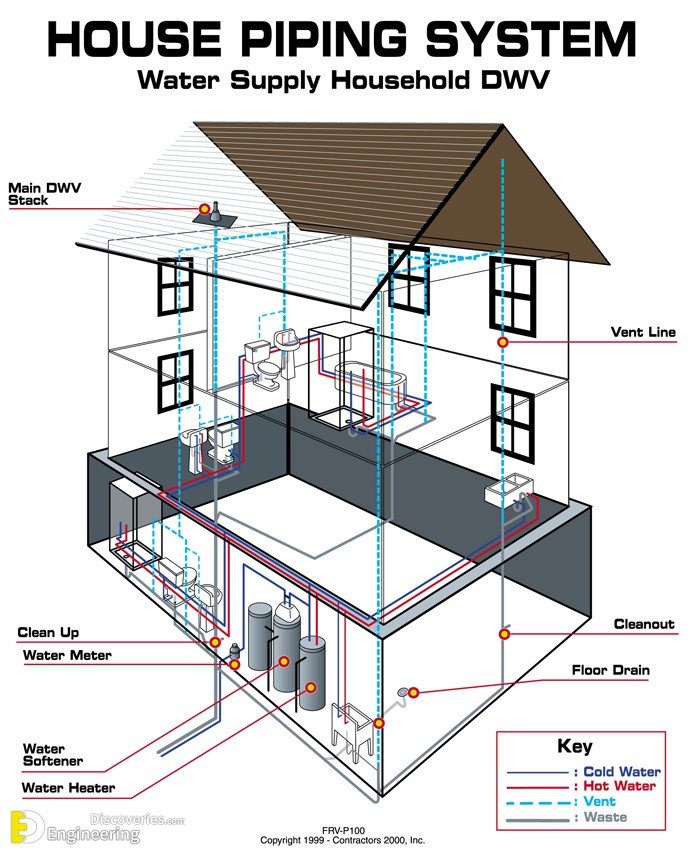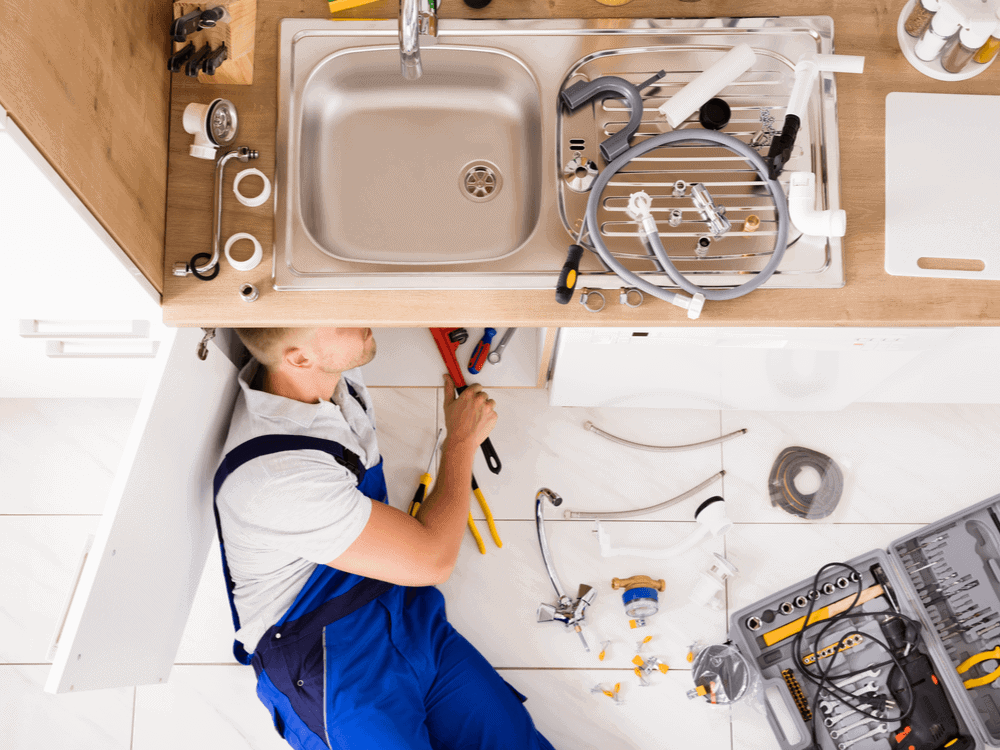Design of Your Home's Plumbing System: What It Matters
Design of Your Home's Plumbing System: What It Matters
Blog Article
Everyone will have his or her own thinking on the subject of The Inner Workings of Your Home's Plumbing.

Understanding exactly how your home's plumbing system functions is crucial for every homeowner. From delivering clean water for drinking, cooking, and bathing to safely removing wastewater, a well-kept plumbing system is important for your family's health and comfort. In this thorough overview, we'll discover the elaborate network that makes up your home's plumbing and offer pointers on upkeep, upgrades, and managing typical problems.
Introduction
Your home's plumbing system is more than just a network of pipes; it's a complex system that ensures you have access to clean water and reliable wastewater elimination. Knowing its parts and just how they collaborate can assist you avoid costly repairs and ensure every little thing runs smoothly.
Standard Elements of a Pipes System
Pipes and Tubing
At the heart of your pipes system are the pipelines and tubing that lug water throughout your home. These can be made from various materials such as copper, PVC, or PEX, each with its benefits in regards to toughness and cost-effectiveness.
Components: Sinks, Toilets, Showers, etc.
Components like sinks, bathrooms, showers, and tubs are where water is used in your home. Recognizing just how these fixtures link to the plumbing system assists in diagnosing troubles and preparing upgrades.
Shutoffs and Shut-off Factors
Valves regulate the circulation of water in your plumbing system. Shut-off valves are critical throughout emergency situations or when you need to make repairs, permitting you to isolate parts of the system without interrupting water flow to the whole house.
Water System
Key Water Line
The main water line attaches your home to the local water or a personal well. It's where water enters your home and is distributed to various components.
Water Meter and Pressure Regulator
The water meter measures your water use, while a stress regulatory authority makes certain that water streams at a risk-free stress throughout your home's pipes system, preventing damage to pipelines and components.
Cold Water vs. Hot Water Lines
Understanding the difference in between cold water lines, which supply water directly from the primary, and hot water lines, which carry warmed water from the hot water heater, helps in fixing and planning for upgrades.
Drain System
Drain Piping and Traps
Drain pipes carry wastewater far from sinks, showers, and bathrooms to the drain or septic tank. Traps prevent drain gases from entering your home and also catch particles that could create blockages.
Air flow Pipes
Ventilation pipes enable air into the water drainage system, stopping suction that could slow down drainage and trigger traps to vacant. Appropriate air flow is necessary for keeping the integrity of your plumbing system.
Importance of Proper Water Drainage
Ensuring proper water drainage avoids back-ups and water damages. Consistently cleaning up drains and keeping catches can prevent expensive repair services and extend the life of your plumbing system.
Water Heating Unit
Kinds Of Hot Water Heater
Water heaters can be tankless or conventional tank-style. Tankless heating units warmth water as needed, while tanks keep warmed water for prompt usage.
Upgrading Your Plumbing System
Factors for Updating
Updating to water-efficient fixtures or replacing old pipes can enhance water top quality, minimize water costs, and increase the value of your home.
Modern Plumbing Technologies and Their Benefits
Check out modern technologies like clever leak detectors, water-saving toilets, and energy-efficient water heaters that can conserve cash and lower environmental impact.
Cost Factors To Consider and ROI
Determine the ahead of time expenses versus long-lasting cost savings when taking into consideration pipes upgrades. Many upgrades pay for themselves through decreased utility bills and fewer repairs.
How Water Heaters Connect to the Pipes System
Comprehending exactly how water heaters link to both the cold water supply and hot water distribution lines helps in diagnosing issues like not enough warm water or leakages.
Upkeep Tips for Water Heaters
On a regular basis purging your hot water heater to get rid of sediment, checking the temperature settings, and checking for leaks can extend its life-span and boost energy efficiency.
Typical Plumbing Issues
Leakages and Their Causes
Leaks can occur due to aging pipelines, loose fittings, or high water stress. Dealing with leaks without delay protects against water damages and mold growth.
Clogs and Clogs
Obstructions in drains pipes and bathrooms are often caused by purging non-flushable products or a buildup of grease and hair. Making use of drain displays and bearing in mind what decreases your drains pipes can stop blockages.
Indicators of Pipes Problems to Expect
Low tide pressure, slow drains pipes, foul odors, or uncommonly high water costs are indications of prospective plumbing troubles that must be addressed without delay.
Pipes Upkeep Tips
Routine Evaluations and Checks
Set up annual pipes assessments to catch concerns early. Search for signs of leakages, corrosion, or mineral build-up in taps and showerheads.
Do It Yourself Maintenance Tasks
Straightforward tasks like cleaning tap aerators, checking for commode leaks using color tablet computers, or protecting exposed pipelines in cold climates can prevent major pipes issues.
When to Call a Specialist Plumber
Know when a pipes issue requires specialist competence. Attempting complicated fixings without appropriate knowledge can cause more damage and greater repair work prices.
Tips for Reducing Water Usage
Straightforward practices like repairing leakages promptly, taking shorter showers, and running full lots of laundry and meals can conserve water and lower your energy bills.
Eco-Friendly Pipes Options
Consider sustainable pipes materials like bamboo for flooring, which is durable and green, or recycled glass for kitchen counters.
Emergency Preparedness
Actions to Take During a Pipes Emergency
Know where your shut-off shutoffs lie and how to shut off the water supply in case of a burst pipe or significant leakage.
Importance of Having Emergency Get In Touches With Helpful
Maintain contact info for neighborhood plumbing professionals or emergency situation services readily available for fast feedback during a plumbing situation.
Ecological Impact and Conservation
Water-Saving Fixtures and Home Appliances
Mounting low-flow taps, showerheads, and commodes can considerably decrease water usage without sacrificing performance.
Do It Yourself Emergency Fixes (When Suitable).
Short-lived solutions like utilizing air duct tape to spot a leaking pipeline or putting a container under a trickling faucet can lessen damages till a specialist plumber arrives.
Final thought.
Comprehending the composition of your home's plumbing system empowers you to maintain it efficiently, saving time and money on repairs. By following regular maintenance regimens and remaining educated concerning modern-day pipes innovations, you can ensure your plumbing system operates efficiently for several years ahead.
Exploring Your Homes Plumbing Anatomy
Water Supply System
Main Water Line: This is where water enters your home from the municipal supply or a private well. Water Meter: Typically located near where the main water line enters the property, it measures the amount of water used. Shutoff Valve: It s crucial to know where this is in case of emergencies. It allows you to turn off the water supply to the entire house. Pipes and Fittings: These distribute water throughout your home. Materials can include copper, PVC, or PEX. Drain-Waste-Vent (DWV) System
Drains: Located in sinks, showers, and tubs, these carry wastewater away. Traps: U-shaped pipes under sinks that hold standing water, blocking sewer gases from entering the home. Vents: Pipes that lead from the DWV system to the outside, preventing vacuum formation and allowing gases to escape. Sewer Line: Carries all wastewater from the home to the municipal sewer system or a septic tank. Fixtures and Appliances
Sinks, Toilets, and Showers Dishwashers and Washing Machines Water Heaters Maintenance Tips
Regularly check for leaks in exposed pipes and around fixtures. Inspect the water heater annually for signs of wear. Clean drains and traps to prevent clogs and odors. Know how to shut off water to individual fixtures. When to Call a Professional
Major leaks or burst pipes Installation of new pipes or fixtures Septic tank issues Remodeling projects that involve plumbing changes Conclusion
Understanding the anatomy of your home's plumbing is key to maintaining a functional and efficient system. Regular checks and knowing when to call in the experts can save you time, money, and stress.
https://www.mavyn.com/blog/exploring-your-homes-plumbing-anatomy

Do you appreciate reading up on Exploring Your Homes Plumbing Anatomy? Create a review below. We would be happy to find out your views about this posting. We are looking forward that you visit us again later on. So long as you appreciated our blog posting kindly make sure you remember to pass it around. Thank-you for your time invested reading it.
Call Today Report this page